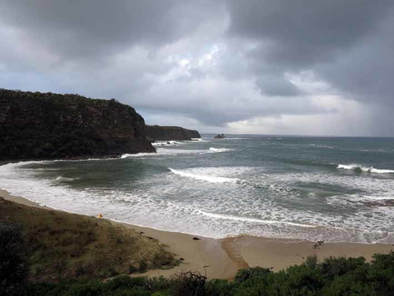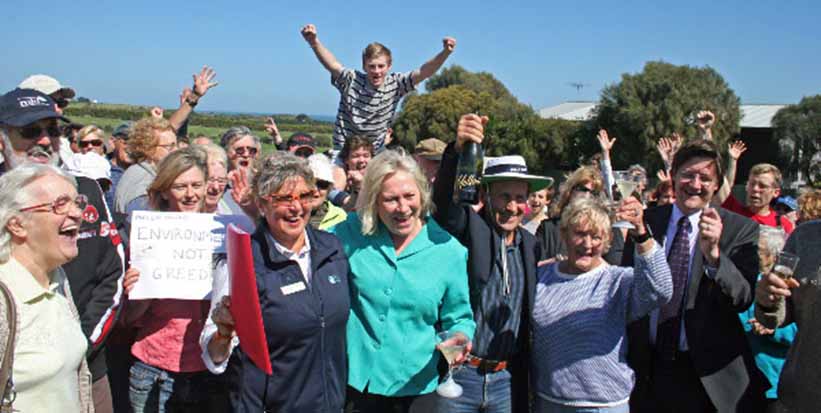 Photo Linda Cuttriss
Photo Linda Cuttriss AS CR Michael Whelan wrote in the previous issue of the Bass Coast Post, several Bass Coast Shire Council strategies are consolidating into an integrated vision for Phillip Island.
This article is written to discuss the existing hurdles that will disrupt the likely delivery of an enhanced natural environment. A poor outcome will not only deprive future generations of Victorians of one of their best recreational destinations but will also prevent locals from getting quality jobs as we would no longer be able to differentiate a visit to the island from one to the overlaoded Mornington Peninisula and Surf Coast.
I’ve divided it into four parts: lack of a big vision; domination of private cars, outdated use of rural land; and uncontrolled dogs.
Other issues relate to noise generation from jet skis, dogs, gyrocopters, helicopters. Future generations will wonder how we ever accepted so much noise.
Big vision – an oasis on a crowded planet
The many strategies for Phillip Island are very consistent but have a very short timeline. Nothing past 2035. Cowes will turn 150 years old in 2018.
The island is a finite geographical entity with limited growth controlled by rigorous town boundaries, so it’s not too difficult to set a clear direction for how the island will be when fully developed by 2070. The Phillip Island Visitor Economy Strategy recommends an optimum capacity of 24,500 visitors per day. If the comfortable carrying capacity of the island is 70,000, this number sounds reasonable. Locals – 15,000, holiday homes – 25,000, penguin visitors – 3000, day visitors – 27,000. The bridge can handle 1200 vehicles (2500 people) per hour.
The objectives of creating a world-best recreational site on the island is possible with fixed geographical boundaries. However, once we have commenced delivering the island to its full potential, the oasis extends. Imagine a two-kilometre strip along the coast from French Island to the Prom! Dream big!
Roads – reduce the domination of private cars
With the current 4 per cent annual vehicle growth, in 30 years we will have three times as much traffic. More traffic means more car parks which means less vegetation which means less economic value of the island.
The Cowes Activity Centre Plan is bold but realistic with car parking at Church St and less car parking at the Jetty Triangle. It states that enjoyment for tourists occurs when people leave their cars. The Phillip Island Integrated Transport Study states that we must reduce the domination of private cars. All the strategies identify the economic value of traffic calming with fewer cars and more public transport, walking and cycling.
We can build multi lanes across the island from San Remo to Cowes but where will the cars park? In Port Douglas, six companies run continuous minibuses. You call them and on the way into town they pick up other passengers. Cars are just a nuisance for owners and for the functioning of the main street and beaches.
Where are Smiths Beach visitors going to park their cars this summer ? When the Cape Woolamai development is completed, there will be an all-mobility path from the Cranny to the surf lifesaving club. This prevents cars from parking on either side of the road. Where will the overflow park ? Lets see fewer cars and cars more mini-buses with trailers.
Google maps currently instructs vehicles to enter Cowes via Coghlan Rd. Where is the strategic planning in that? The worst decision in the past 30 years was the siting of the light industrial area in Settlement Road. Certain councillors of the day argued that it should be located opposite Wimbledom Heights on Gap Road.
We now have the absurd situation where one terrible decision leads to a worse one: the main thoroughfare to the town along Coghlan Road. It must be reversed with 40km/h limits and speed bumps, making the entire north-east corner of the island a wildlife wonderland.
The key economic driver is to help small business increase off-peak trading. By sending the Cowes traffic down Gap Road to join the racetrack and penguin traffic, the north-east becomes 40 kilometres of walking and riding, a great incentive for holiday home owners and day visitors to enjoy winter visits.
Future generations will enjoy and be willing to pay for such excellent environmental values. Drivers must understand that quality jobs for their kids is the compensation for an extra two minutes for the trip.
Rural land – a wasted, precious resource
The worst performing strategy developed by Bass Coast Shire Council in recent years is the Rural Land Use Strategy. It made the vague and incorrect assumption that rural land is viable for primary production. Most rural lots are 80 acres, with some 10 acres. They are unviable for families to make a living.
This shouldn’t be seen as a problem for landowners but as a great opportunity. There are many uses for rural land beyond agriculture. The best use of this very scarce resource on Phillip Island is first, small tourist farms and second, restoration of native vegetation with public access. Stands of unique coastal vegetation on on private land must be protected and weed infestation removed. We are all in this together.
There are numerous other profitable uses of rural land: car parking, dog running areas, landscaped tourism facilities, small caravan parks, jazz clubs, health spas, surf schools, music clubs. Families could come and stay, enjoying weeked rambles and enjoying the amazing coastal amenity during the off season. Farmers will benefit immensely with handsome superannuation payments.
Dogs – logical people become irrational
The days of dogs on beaches is fast becoming outdated. Phillip Island Nature Strategic Plan aspires to play a major role in protecting our native threatened species. Goodbye dogs.
It was telling that the state Minister for the Environment banned dogs on the Mornington Peninsula southern coastal area to protect the hooded plovers yet dogs are still permitted on Phillip Island’s south coast.
Dog owners are incredibly passionate about the right of their dogs to run off-leash and we must transition to dog running areas. Council/PINP could work together to lease or buy degraded farmland, build a dam, construct a café/bar and charge users $100 per year to let their dogs do their thing.
The time is now
The history of European occupation of the island can be summarised in four quarters:
- Settlement, burning and clearing all native and surveying a miserable 30-metre coastal strip for crown land.
- The 1950s when subdivisions were permitted with no public open space, no services and rampant land clearing.
- Phillip Island Nature Parks is established. Brilliant comeback – well resourced, good income and focus on conservation – recognition that the environment is the economy.
- Now. The thinking has been done the strategies are in place. If we work together the entire coast can become a world wonder – an oasis on a crowded planet. The economic benefits will be exceptional.
The question now is whether we have the will.
Phil Wright is a former councillor of both the Phillip Island and Bass Coast shire councils. He lives at Smiths Beach.
